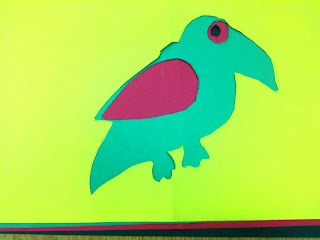Molas are a form of reverse applique using many layers of fabric. In a later lesson we will sew simple molas out of layers of felt. In the mean time let's make one out of construction paper so that we can better understand the reverse applique process.
 |
| First, choose an image that inspires you. Choose a design with simple colorful shapes. |
Flowers, birds, fish and suns all work well as mola designs.
 |
| Next create a simple line drawing. Notice how wide the feet are? You will need to cut out your design so make sure to compose it of bold simple shapes that you can easily cut. |
The top layer is yellow with a bird shaped hole cut out of the middle.
Whenever I need to cut a hole out from the middle of a paper, I pinch the paper and make a tiny cut on the fold. Then I open the paper, stick the scissors in the hole and continue cutting. Pointy scissors can fit into smaller holes than blunt tipped scissors, allowing for more precise cutting.
Now lets begin to put the design together:
 |
| Layer 1 |
 |
| layer 1 and 2 |
 |
| layer 1, 2 and 3 |
 |
| All four layers together Have some fun with your mola by adding some pattern cut outs to layers 2 and 3. |
For more extensive information on molas visit
Learn about the Kuna people of Panama by clicking here.
Learn more about this art form by clicking here
The most common mola motifs are;
birds, fish, animals and flowers.
birds, fish, animals and flowers.
I have created some simplified patterns based on common images from real molas.
Feel free to download or print them or use them as inspiration for your own ideas. 




 |
 |
Start with a simple design of three layers. You can always increase the complexity and detail of a paper mola design by adding more layers of color.
Paper molas make beautiful cards and framed pictures. You can sew or glue simple molas using felt. Felt is a good material for children to use because you do not have to worry about the edges fraying. Kuna women use light weight cotton fabric to make molas. They cut a fringe along the fabric opening and tuck the edges of material underneath to create a clean design. The hallmark of good mola craftsmanship is that you appreciate the image before you notice the materials used to create it. This is true no mater what media you use. Sloppy stitching, visible glue, loose threads or ripped paper all detract from the quality of the design. Nancy Walkup, the editor of School Arts Magazine, writes about using Mola designs as a vehicle to teach big ideas to children: http://www.slideshare.net/mobile/nwalkup/teaching-with-big-ideas |





Bless you for your site. I am not a teacher or student. At 68, I am learning to draw and use watercolor pencils and having fun :) I lived in the Republic of Panama over 12 years and have such wonderful memories. It is a thrill to see this tutorial. Betty
ReplyDeleteIn your video, you show a mola that I have an original. It was given to me several years ago by a dear polish friend who had visited the polish sailors when they had docked their tall ship in at the New York Harbour. These polish lads sold many of their "molas" because apparently they were broke. Fortunate for me, I was given the one that was a representation of the human heart. It was worn as part of the Kuna native's blouse. It was faded somewhat and was sun rotted in places. Never the less, it is an amazing piece of art work and it never fails to intrigue me. The needle work is such that you can barely see the stitches.
ReplyDelete